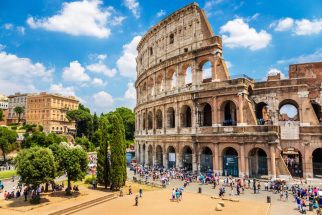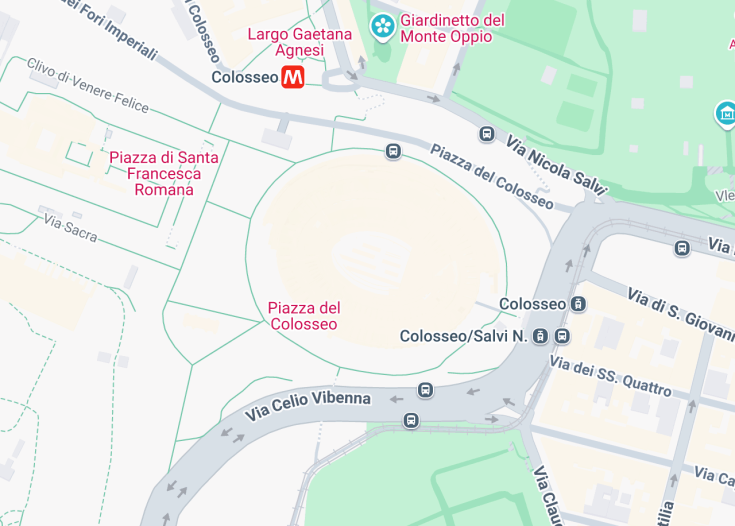The Colosseum, situated in the heart of Rome, Italy, is a monumental amphitheater renowned for its historical significance and architectural grandeur. Erected between 70 and 80 AD, it stands as a testament to Roman engineering prowess and serves as a symbol of the city’s ancient glory, attracting millions of visitors each year.
For an enriching experience at the Colosseum, consider visiting early in the morning or late in the afternoon to avoid large crowds. This timing allows for a more intimate exploration of the site’s intricate architecture and fascinating history.
Advance booking of tickets to the Colosseum is highly recommended, especially during the peak tourist seasons. Opt for a guided tour to fully appreciate the site’s extensive history and unique features, including the arena floor and underground chambers.
Explore the Architectural Marvel of the Colosseum in Rome, Italy
The Colosseum, also known as the Flavian Amphitheater, is a monumental testament to ancient Roman engineering and architectural ingenuity. This elliptical structure, measuring 156 meters in width and 188 meters in length, showcases a sophisticated design with a complex system of entrances. The Colosseum could accommodate an estimated 50,000 spectators, featuring a tiered seating arrangement that reflected the social hierarchy of Roman society. The podium was reserved for the elite, while upper tiers catered to the general populace. A remarkable feature of the amphitheater is its hypogeum, a subterranean network of tunnels and chambers that housed gladiators and wild animals, highlighting the elaborate staging of brutal spectacles.
The exterior of the Colosseum is equally impressive, traditionally featuring three levels of arches adorned with columns of Doric, Ionian, and Coriinthian styles. An additional fourth level was added later, giving the facade a tiered appearance enhanced by the now-missing velarium that shaded spectators. The structure is constructed from travertine limestone, demonstrating the Romans’ expertise in utilizing local materials while maintaining structural integrity. Its sheer scale and architectural details make it not only a symbol of ancient Rome’s prowess but also a marvel of historic preservation and restoration efforts in modern times.
History
29 BC – 64 AD: The Origins and Predecessors
The journey towards the Colosseum began with the construction of the first stone amphitheater in Rome, the Amphitheater of Statilius Taurus, inaugurated in 29 BC. However, this venue was destroyed by the Great Fire of Rome in 64 AD during Nero’s reign, paving the way for a grander structure. Nero’s subsequent construction of the Domus Aurea set the stage for a significant transformation of the land.
72 – 80 AD: Construction Under the Flavians
Initiated by Emperor Vespasian in 72 AD, the Colosseum was designed as a gift to the Roman populace, solidifying the Flavian dynasty’s reputation. Completed in 80 AD under his son Titus, the amphitheater was inaugurated with extravagant games including naval battles and gladiatorial contests, marking the Colosseum’s significance as the epicenter of Roman entertainment.
5th – 6th Century: Decline and Transformation
Despite its initial success, the Colosseum faced a decline during the late Roman Empire due to shifting social and political dynamics. Games continued into the 5th century, but eventually diminished as Christianity rose. By the 6th century, the Colosseum was repurposed as housing by locals, indicative of the changing lives within the ruins of once-grand spectacles.
6th Century – Present: Restoration and Preservation
Throughout the Middle Ages, the structure was pillaged for its stones. By the 18th century, it gained recognition as a sacred site, reinforced by its association with Christian martyrs. Modern restoration efforts began in earnest in the 19th Century, acknowledging its value as a cultural heritage site. Today, the Colosseum stands as a UNESCO World Heritage site and symbol of Rome’s historical legacy.
Experiences and Attractions at the Colosseum in Rome
The Colosseum offers visitors a captivating glimpse into ancient Roman life and culture. Guided tours provide in-depth insights into the structure’s history and architectural significance, while allowing guests to explore the hypogeum and arena floor. Interactive exhibits showcase the engineering feats that allowed for the complex staging of events. Additionally, the nearby Roman Forum and Palatine Hill enhance the excursion, creating a comprehensive experience of Rome’s imperial past.
Significant Engineering Innovations
An essential aspect of the Colosseum’s design is its intricate system of escape routes, known as vomitoria, which allowed swift exit for audiences. This engineering marvel enabled rapid egress in emergencies, reflecting the Romans’ forward-thinking approach to public safety. The amphitheater’s capacity and advanced staging technology for performances contributed significantly to the entertainment culture of ancient Rome.
General informations
Location
The Colosseum is situated in the heart of Rome, easily accessible by public transportation. It is located near iconic landmarks such as the Roman Forum and Palatine Hill.
Address:
Piazza del Colosseo, 1, 00184 Roma RM, ItalyVisiting Information
The Colosseum is open to the public, with tickets available for purchase online or at the entrance. It can be visited freely, but to avoid large crowds, it is recommended to go early in the morning or late in the afternoon.
How to Reach the Colosseum
Car
The Colosseum can be easily reached by car. There are several parking lots nearby for a nominal fee, though it is recommended to arrive early due to limited parking space.
| Route | Distance | Travel time |
|---|---|---|
| From Rome Airport | 30 miles (48Km) | 45 minutes |
| From Vatican City | 2.5 miles (4Km) | 15 minutes |
| From Termini Station | 1 mile (1.5Km) | 10 minutes |
Public Transport
The Colosseum is well-connected by public transportation, with nearby bus and metro services (guide to the Metro in Rome, on ArcheoRoma.org).
| Route | Distance | Travel time |
|---|---|---|
| From Rome City Center | 1 mile (1.5Km) | 15 minutes by bus |
| From Vatican City | 2.5 miles (4Km) | 30 minutes via Metro Line A to Termini, then Metro Line B to Colosseo |
By taxi
Taxi is an effective way to get around Rome (guide to taxis in Rome, on ArcheoRoma.org).
Limo service (NCC)
Opting to car rent with driver is also a good solution, with similar costs as taxis. You can easily book your ride on ArcheoRoma.org website)
Accessibility and Limitations
The Colosseum has made efforts to improve accessibility, including ramps and designated areas for visitors with mobility challenges. However, some areas may still be difficult to access due to the structure’s ancient design.
Accessibility
Limitations
- Some areas remain uneven and may pose a challenge for wheelchair users.
- Stair access is required for certain viewing platforms.
- Crowds can be significant, especially during peak tourist seasons.
Notes to visitors
- Large bags and backpacks are not permitted inside.
- Photography is allowed, but flash use is restricted.
- Food and drink consumption may be limited in certain areas.
Common questions
What are the best ways to explore the Colosseum?
Exploring the Colosseum can be an unforgettable experience. One of the most rewarding ways to discover this iconic landmark is by taking a guided tour. A knowledgeable guide can provide deep insights into the history, architecture, and stories of those who fought within its ancient walls.
Alternatively, visitors can choose to explore the Colosseum on their own. Audioguides are available for rent, offering a self-paced option to learn about the monument as you navigate through its vast structure.
For a more unique experience, consider booking a night tour or a special event, which offers a different perspective of the amphitheater after dark. This serene experience showcases the Colosseum beautifully illuminated, making it magical and photogenic.
Lastly, if you’re looking for a more interactive experience, consider participating in activities such as gladiator training workshops nearby. This can add a fun and engaging aspect to your visit while giving you a taste of the warrior life in ancient Rome.
What should I wear when visiting the Colosseum?
When visiting the Colosseum in Rome, comfortable and practical clothing is recommended due to extensive walking and standing involved. Lightweight fabrics are advisable, especially during the summer months when temperatures can soar.
It is best to wear sturdy footwear, like sneakers or comfortable walking shoes, to help navigate the ancient cobblestone paths and uneven surfaces typical of the Colosseum and surrounding Roman Forum area.
Consider dressing in layers. Mornings can be cool, while afternoons tend to be warmer; by layering, you can ensure comfort throughout the day. Lastly, don’t forget to bring along a sun hat and sunglasses during peak summer, as the Roman sun can be quite strong, and the Colosseum can be exposed.
Are there any specific tourist etiquette tips I should follow at the Colosseum?
When visiting the Colosseum, it’s important to adhere to a few etiquette tips to respect this historic site. Firstly, maintain a respectful demeanor, acknowledging that the Colosseum is a monument of significant historical value and a reminder of past struggles.
Secondly, be mindful of noise levels. Keep conversations at a reasonable volume to not disturb other visitors who may be trying to take in their surroundings in peace.
Photography is generally allowed, but using tripods or selfie sticks can obstruct views and pathways, so it’s best to avoid them. Also, ensure that you’re not blocking access points when taking photos.
Lastly, be aware of your personal belongings. The Colosseum can get crowded, so it’s wise to keep an eye on your items to prevent theft or loss.
What are some notable features of the Colosseum that I should look out for during my visit?
The Colosseum, a marvel of ancient engineering, boasts several notable features worth observing during your visit. Look for the intricate design of the Arch of Constantine, located just outside the Colosseum. This structure honors the Roman Emperor Constantine I and showcases impressive relief sculptures.
Within the amphitheater, pay attention to the elaborate tiered seating arrangement, which demonstrates how spectators were organized based on social class. The podium for senators and the upper levels for the general public reflect Rome’s class structure.
Another key feature is the extensive underground hypogeum, which was used for holding gladiators and animals before contests. While access to this area may be limited, many tours include explanations about its significance.
Don’t forget to notice the magnificent arches and columns showcasing the classic Roman architectural style. The different orders of columns—Doric, Ionic, and Corinthian—highlight the artistic evolution characteristic of Roman architecture.
Can I bring food or drinks to the Colosseum?
Visitors are permitted to bring food and drinks to the Colosseum, but there are some important guidelines to keep in mind. While enjoying a snack or beverage as you explore is acceptable, it’s advised to keep consumption to a minimum to preserve cleanliness and the monument’s integrity.
Remember that picnicking directly on the Colosseum grounds is not allowed, so it’s best to enjoy your refreshments at designated areas nearby, such as the Roman Forum or surrounding parks after touring the Colosseum.
Additionally, be prepared for security checks at the entrance where larger bags and containers may not be permitted. This means that snacks should be in manageable sizes, and beverages should be in non-glass containers to ensure a hassle-free experience.
Overall, staying respectful and keeping the area tidy makes for a more enjoyable visit for everyone.

Is the Colosseum in Rome, Italy worth visiting?
Absolutely, the Colosseum is a must-visit for anyone traveling to Rome. This iconic structure is not only the largest ancient amphitheater ever built, but it also symbolizes the grandeur of Roman architecture and engineering. When you step inside, you’re transported back to a time of gladiators and grand spectacles, providing a visceral connection to history. The guided tours available enhance the experience, offering insights into the well-documented and rich past of this landmark. The surrounding area also features other historical sites like the Roman Forum and Palatine Hill, making it a hub for culture and heritage. Additionally, the Colosseum’s illumination at night creates a breathtaking spectacle. Visitors consistently leave with a deeper appreciation for the enduring legacy of the ancient Romans, making it a worthwhile stop on any Italian itinerary.








